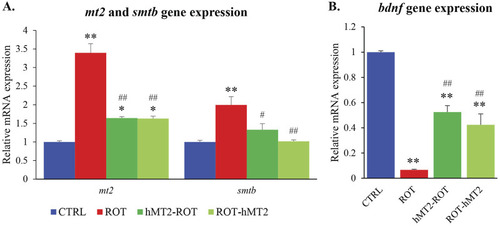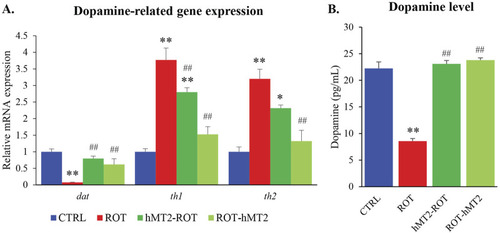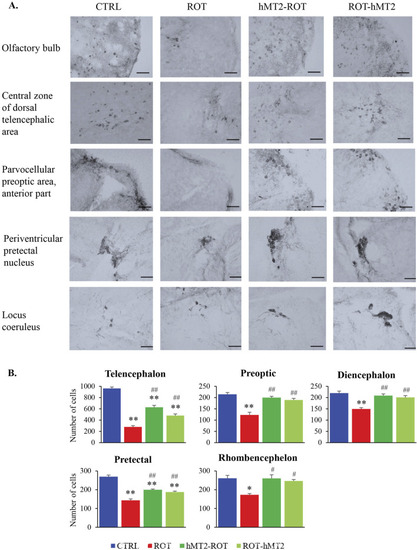- Title
-
Metallothionein II treatment mitigates rotenone-induced neurodegeneration in zebrafish models of Parkinson's disease
- Authors
- Nies, Y.H., Lim, W.L., Abd Karim, N., Yahaya, M.F., Teoh, S.L.
- Source
- Full text @ Front Pharmacol
|
Experimental design of animal groups and treatment timeline. Fish were divided into 4 groups (n = 15 per group), namely, control (CTRL), rotenone-treated PD model (ROT), hMT2 pretreatment (hMT2-ROT), and hMT2 co-treatment (ROT-hMT2) groups. PD was induced in zebrafish using 5 μg/L rotenone water for 28 days. hMT2 was intracranially injected a day before (hMT2-ROT) or 7 days after (ROT-hMT2) the rotenone exposure. |
|
Effects of rotenone on locomotor activity of adult zebrafish. |
|
Effects of rotenone and hMT2 on metallothioniein and |
|
Effects of rotenone and hMT2 on dopamine-related genes expression and dopamine levels. |
|
Effects of rotenone and hMT2 on brain inflammation. |
|
Effects of rotenone and hMT2 on dopaminergic neuron population. |
|
Effects of rotenone and hMT2 on mitochondria function. Representative phenetic maps of CTRL, ROT, hMT2-ROT and ROT-hMT2 mitochondria in the presence of mitochondria-centered drugs for 6 h, generated after normalization of the optical density values of each drug concentration at 590 nm (purple color) to those of the positive-control wells included in the MitoPlate™ I-1 plates. #p < 0.05, ##p < 0.001 vs. ROT (n = 3 per group). |
|
Effects of rotenone and hMT2 on dye reduction kinetics in mitochondria with complex II inhibitors (malonate and carboxin) and meclizine. The graphs showed representative reduction dynamics of the dye over time measured as absorbance at 590 nm for 6 h at 5-min intervals. ROT group exhibited significantly slower dye reduction, indicating mitochondrial dysfunction. Both hMT2-ROT and ROT-hMT2 groups showed improved dye reduction rates compared to ROT, suggesting restored mitochondrial function. |








